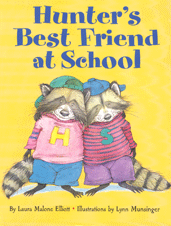
[ Back to Picture Books ] -> [ Back to Hunter's Best Friend at School ]
Author's Notes
Hunter's Best Friend at School

The last thing I wanted to do with my child was to repeat that age-old: "If everyone else jumps off a cliff would you do it, too?" And I definitely had to acknowledge that acting silly can be kind-of fun. So I made up Hunter's Best Friend at School as a bedtime story.
Much of the plot came from real life and my work as a journalist. As a writer with the Washingtonian magazine, I had the privilege of interviewing many child development specialists. I learned from these experts that some of the best "behavior modification" involves the simplest of things: ignoring, distracting, or modeling desired behavior. Plus, the most productive censorship typically comes from playmates.
And so, in Hunter's Best Friend at School, after initially joining in the mischief-making, Hunter returns to school, instinctively employing the very techniques child psychologists might recommend. Hunter ignores Stripe even as Stripe bounces a minnow off this head during snack time. He distracts Stripe with artwork to stop him from planting two paint-filled paws on Luna's clean dress. Eventually, Stripe responds to Hunter's pressure. As Hunter's Mom tells him, "Being a best friend doesn't mean always following along. Sometimes being a best friend means you have to help your friend be his best self."
School Library Journal has called Hunter's Best Friend at School endearing and entertaining, "filling a need for stories about friendship and peer pressure." But I think Hunter's success has to do mostly with the enormous talents of Lynn Munsinger, illustrator of The Teeny Tiny Ghost, God Bless America, and What Mommies Do Best. Her "comical and sometimes poignant" (Publishers Weekly) watercolors make Hunter and his pals "irresistibly cute and cuddly" (Kirkus Reviews).
Hunter's Best Friend at School is the first in a three book series that explores peer pressure, sibling rivalry, and competitiveness.
P.S. — I'm thrilled that Hunter's Best Friend at School is used by many educators and school counselors in discussing classroom behavior and the importance/responsibility of friendship. Hunter has also been been included in an anthology written by child psychologist, Dr. Jacqueline Golding. Healing Stories: Picture Books for the Big and Small Changes in a Child's Life is designed to guide parents to published books that can help children through everyday challenges, developmental transitions, and stressful events. You can learn more about using books in such discussion by visiting her website: www.healing-stories.com.
Much of the plot came from real life and my work as a journalist. As a writer with the Washingtonian magazine, I had the privilege of interviewing many child development specialists.
